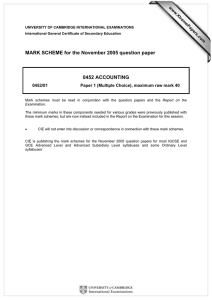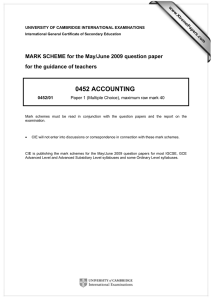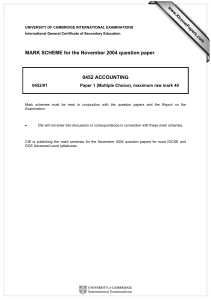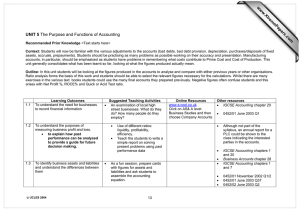www.XtremePapers.com
advertisement
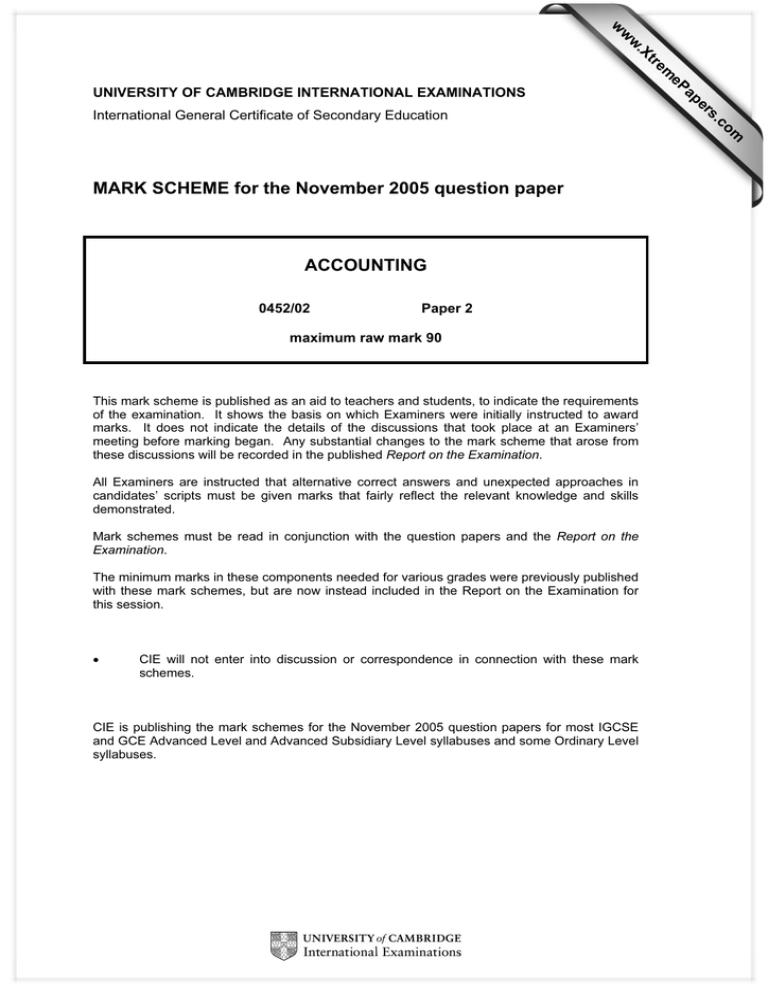
w w ACCOUNTING 0452/02 Paper 2 maximum raw mark 90 This mark scheme is published as an aid to teachers and students, to indicate the requirements of the examination. It shows the basis on which Examiners were initially instructed to award marks. It does not indicate the details of the discussions that took place at an Examiners’ meeting before marking began. Any substantial changes to the mark scheme that arose from these discussions will be recorded in the published Report on the Examination. All Examiners are instructed that alternative correct answers and unexpected approaches in candidates’ scripts must be given marks that fairly reflect the relevant knowledge and skills demonstrated. Mark schemes must be read in conjunction with the question papers and the Report on the Examination. The minimum marks in these components needed for various grades were previously published with these mark schemes, but are now instead included in the Report on the Examination for this session. • CIE will not enter into discussion or correspondence in connection with these mark schemes. CIE is publishing the mark schemes for the November 2005 question papers for most IGCSE and GCE Advanced Level and Advanced Subsidiary Level syllabuses and some Ordinary Level syllabuses. om .c MARK SCHEME for the November 2005 question paper s er International General Certificate of Secondary Education ap eP m e tr .X w UNIVERSITY OF CAMBRIDGE INTERNATIONAL EXAMINATIONS Page 1 Mark Scheme IGCSE – November 2005 Syllabus 0452 Question Question (including any source details) Number Paper 02 Part mark Cash book [1] A reduction in price allowed for bulk purchases or to a regular customer [1] (c) Current liabilities [1] (d) Imprest system [1] (e) The net amount for which the stock may be sold [1] (f) (i) Trading Account [1] (ii) Profit and Loss Account [1] 1 (a) (b) (g) Purchase of motor van. Capital Expenditure √ (1) New tyres for motor van. Painting business name on motor van. Cost of oil for motor van engine. Revenue Expenditure √ (1) √ (1) √ (1) [4] (h) (i) Gross profit ($45 000) less expenses ($30 000) = net profit ($15 000) ROCE = 15 000 (1) ⁄ 150 000 (1) = 10% (1). [3] “Current” (1) assets less “Current” (1) liabilities. [2] [Total 16] © University of Cambridge International Examinations 2005 Page 2 Mark Scheme IGCSE – November 2005 Syllabus 0452 Question Question (including any source details) Number 2 (a) (b) Paper 02 Part mark (i) 3 000 [1] (ii) $100.00 [1] (iii) $1 300.00 [1] (iv) Cash discount [1] (i) $75.00 [1] (ii) $2 425.00 [1] (iii) Nil [1] (iv) $1 300.00 [1] General Supply Company Account (c) Date 2005 5 September 30 September 30 October $ Bank Discount 2 425 (1)OF 75 (1)OF Balance c/d 1 300 3 800 Bank 1 300 (1)OF Date 2005 1 September 25 September $ Balance b/d Purchases 2 500 (1) 1 300 (1)OF 3 800 1 October Balance b/d 1 300 Running balance acceptable. 1 300 (1)OF 1 300 [6] [Total 14] © University of Cambridge International Examinations 2005 Page 3 Mark Scheme IGCSE – November 2005 Syllabus 0452 Question Question (including any source details) Number 3 (a) Paper 02 Part mark Smith Trading and Profit and Loss Account Year ended 30 June 2005 $ Sales Opening stock Purchases (75,600 + 4,000) Carriage inwards less: closing stock $ 102 000 (1) 8 400 (1) 79 600 (2) 700 (1) 88 700 7 100 (1) Cost of sales (1) 81 600 (1) Gross profit 20 400 (1) OF Advertising Provision for depreciation of fixed assets General expenses Insurance Lighting and heating Motor expenses (860 + 350) Office expenses Rent Postage and stationery Wages and salaries 400 (1) 700 (1) 390 ) 420 )(1) 600 ) 1 210 (1) 280 ) 720 )(1) 180 ) 5 250 (1) 10 150 10 250 (1)OF Net profit (Horizontal presentation acceptable) (b) (i) Gross profit percentage (ii) Net profit percentage [16] = gross profit/sales = 20 400 / 102 000 x 100 = 20.00% (1)OF (1) = net profit/sales = 10 250 / 102 000 x 100 = 10.05% (1)OF (1) © University of Cambridge International Examinations 2005 Page 4 Mark Scheme IGCSE – November 2005 Syllabus 0452 Question Question (including any source details) Number (c) Paper 02 Part mark Jones may charge higher prices for his goods, possibly because they are in high demand Jones can buy his goods more cheaply, take advantage of trade discount Other similar points up to 2 marks each [4] [Total 24] 4 (a) To charge the cost of the capital expenditure to profits earned over the useful life of the asset (or similar acceptable answer) [2] (b) Year ended 30 September Straight line method $ 2005 3 600 (1) 2006 3 600 2007 3 600 Reducing balance method $ 8 000 (1) 6 400 (1)OF (1) 5 120 (1)OF [5] © University of Cambridge International Examinations 2005 Page 5 Mark Scheme IGCSE – November 2005 Syllabus 0452 Question Question (including any source details) Number Paper 02 Part mark (c) Date 2005 30 September $ Balance c/d Date 2005 8 000 30 September $ Profit and loss account 8 000 1 October 2006 30 September Balance c/d 14 400 2006 30 September Balance b/d Profit and loss account 14 400 1 October 2007 30 September Balance c/d 19 520 2007 30 September 19 520 1 October Balance b/d 8 000 (1)OF 8 000 8 000 (1)OF 6 400 (1)OF 14 400 14 400 (1)OF Profit and loss account 5 120 (1)OF 19 520 Balance b/d 19 520 (1)OF + (1) for all dates correct. [7] [Total 14] © University of Cambridge International Examinations 2005 Page 6 Mark Scheme IGCSE – November 2005 Syllabus 0452 Question Question (including any source details) Number Paper 02 Part mark Anvil Balance Sheet at 31 August 2005 5 (a) Fixed assets Cost Plant and machinery Motor cars $ 45 000 (1) 22 000 (1) 67 000 Current assets Stock Debtors Prepayments Bank and cash less: Current liabilities Accruals Creditors Depreciation Net Book Value $ 33 000 (1) 16 600 (1) 49 600 $ 12 000 (1) 5 400 (1) 17 400 16 000 (1) 52 000 (1) 1 800 (1) 22 400 (1) 92 200 3 300 (1) 32 000 (1) 35 300 Net current assets (working capital) 56 900 106 500 15 000 (1) 91 500 Long term liability – Bank loan Capital Balance at 1 September 2004 Net profit less: drawings 91 000 (1) 30 500 (1) 121 500 30 000 (1) 91 500 [16] © University of Cambridge International Examinations 2005 Page 7 Mark Scheme IGCSE – November 2005 Syllabus 0452 Question Question (including any source details) Number (b) (i) Paper 02 Part mark Bank + Debtors + Prepayments + Stock Accruals + Creditors 22 400 + 52 000 + 1 800 + 16 000 = 92 200 (1) 3 300 + 32 000 = 35 300 (1) Current ratio = 2.61:1 (1)OF (ii) [3] As above without stock 76 200 (1)/35 300 (1) Quick ratio = 2.16:1 (1)OF [3] [Total 22] © University of Cambridge International Examinations 2005
